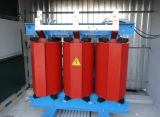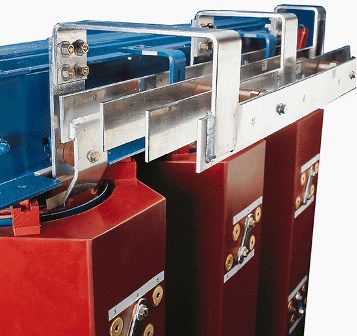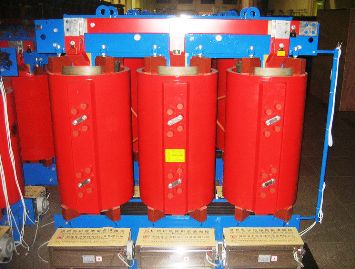Dry insulated transformers
 Dry type transformers are air cooled transformers. The heat from the heated parts of such transformers is removed by natural air currents. For transformers with a power of up to 2500 kW with a winding voltage of up to 15 kV, such free cooling is quite sufficient.
Dry type transformers are air cooled transformers. The heat from the heated parts of such transformers is removed by natural air currents. For transformers with a power of up to 2500 kW with a winding voltage of up to 15 kV, such free cooling is quite sufficient.
Such transformers find their application in places where there are increased requirements for the safety of people and equipment. Powerful dry transformers are used: in industrial metallurgical enterprises, in the petroleum industry, in the pulp and paper industry, in machine building, as well as in the power supply of public buildings, structures and transport.
The low voltage (LV) and high voltage (HV) windings of the transformer are enclosed in a protective casing, and atmospheric air serves as the main cooling and insulating medium for them. Compared to oil, air has significantly poorer insulating properties, which is why the requirements for insulation of transformer dry windings are much higher.
These transformers are installed only in dry, closed rooms (humidity not higher than 80%), because their windings are moistened in contact with air, and in order to reduce the hygroscopicity of the windings, they are additionally impregnated with special varnishes.

Dry-type transformers are available in three different designs: open coil, monolithic coil, and cast coil.
Open-wound transformers are impregnated with vacuum pressure resin and have an insulating coating up to 0.2 mm thick, which ensures both high insulation and environmental protection, while cooling the coils remains very efficient.
For effective cooling of the windings, special insulation profiles and high-strength porcelain insulators are used, which form horizontal and vertical cooling channels, and thanks to convection, resistance to contamination is ensured here.
The monolithic construction is cast in a high vacuum, and during operation such epoxy casting does not release any products, which allows the transformer to be freely used where the requirements for environmental and fire safety are increased, for example, in built-in substations with aggressive electrical operating conditions equipment.
The insulation of the wires ensures high electrical strength, and the bandage strips guarantee strength after varnish impregnation and baking, providing high mechanical strength. This technology allows long-term use of the equipment in modes of cyclic thermal loads without the risk of loss of insulation of its electrical characteristics.

Special fillers for the production of cast coils provide improved mechanical, fire-resistant and heat-conducting properties, thus the technology itself gives the structure rigidity. The use of a cast winding makes it possible to obtain a transformer of acceptable dimensions for operation in high-voltage networks.
However, there are also disadvantages: the mass of the insulating material is large and there are inhomogeneities, due to which there is a possibility of partial discharges, and the cooling of the high-voltage windings is also difficult. As the temperature drops, mechanical stresses often occur in the insulation.
Dry-type transformers have a number of advantages over oil transformers:
-
require no maintenance costs: no need to clean and change the oil.
-
return on investment: compared to oiled counterparts, the cross-section of the wires and the magnetic circuit increases accordingly, the electromagnetic load on the active materials decreases, which with increasing voltage on the windings and at high powers has a very economic effect. New heat-resistant non-combustible materials work to increase useful electromagnetic loads and reduce active material costs.
- high safety: the working temperature increases due to the use of asbestos or fiberglass as insulating materials;
-
has a protective cover;
-
applicable in dry rooms with high requirements for fire safety.
